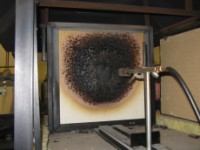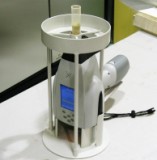Can you handle the heat? – Assessing Composites in Firewalls for Mass Transit Vehicles
 The CIC recently investigated the feasibility of building a firewall for a mass transit vehicle from composite materials. The goal was to reduce the weight and part counts of current metallic firewall systems while remaining cost competitive. Prospective materials were qualified using the CIC’s radiant panel flame spread apparatus according to ASTM E162 – Standard Test Method for Surface Flammability of Materials Using a Radiant Heat Energy Source. The initial testing indicated promising results for panels fabricated with 1.5 oz chopped strand mat, 10 oz cloth, 18 oz woven roving, and Norsodyne H 81269 TF flame retardant polyester resin. Additionally, the fire exposed surfaces of the panels were treated with PyroTarp, an intumescent coating that was applied like paint after the panels were cured. When exposed to high temperatures both the Norsodyne resin and PyroTarp expand to form a char by-product on the surface of the part. The char acts as an insulating layer between the flame and the glass fibres. In order to gain approval from transit authorities a composite firewall panel is required to pass the specifications laid out in Federal Transit Administration Docket 90-A. It specifies that the panels must achieve a 15 minute rating at a furnace temperature of 1,550°F according to ASTM E119 – Standard Test Methods for Fire Tests of Building Construction. A panel is considered to have passed when no flame or gases breach the panel and the temperature rise on the unexposed surface does not exceed 139°C. Preliminary trials were performed at North Dakota State University using a single propane burner with a flame temperature of 1,350°F in a semi-enclosed chamber. After 30 minutes the flame had not penetrated the test panels and the temperature rise was well below the allowable. However, when the panel was tested using the ASTM E119 method in a fully enclosed chamber with a furnace temperature of 1,550°F the average temperature rise exceeded 139°C after 4.3 minutes. Alastair Komus, the Principal Engineer for the CIC’s Ground Transportation Sector team concluded, “The results from the initial tests of a composite firewall were encouraging, but further research is required. Future testing should focus on composite sandwich panels that use either a composite core or air gap to improve the final results.”
The CIC recently investigated the feasibility of building a firewall for a mass transit vehicle from composite materials. The goal was to reduce the weight and part counts of current metallic firewall systems while remaining cost competitive. Prospective materials were qualified using the CIC’s radiant panel flame spread apparatus according to ASTM E162 – Standard Test Method for Surface Flammability of Materials Using a Radiant Heat Energy Source. The initial testing indicated promising results for panels fabricated with 1.5 oz chopped strand mat, 10 oz cloth, 18 oz woven roving, and Norsodyne H 81269 TF flame retardant polyester resin. Additionally, the fire exposed surfaces of the panels were treated with PyroTarp, an intumescent coating that was applied like paint after the panels were cured. When exposed to high temperatures both the Norsodyne resin and PyroTarp expand to form a char by-product on the surface of the part. The char acts as an insulating layer between the flame and the glass fibres. In order to gain approval from transit authorities a composite firewall panel is required to pass the specifications laid out in Federal Transit Administration Docket 90-A. It specifies that the panels must achieve a 15 minute rating at a furnace temperature of 1,550°F according to ASTM E119 – Standard Test Methods for Fire Tests of Building Construction. A panel is considered to have passed when no flame or gases breach the panel and the temperature rise on the unexposed surface does not exceed 139°C. Preliminary trials were performed at North Dakota State University using a single propane burner with a flame temperature of 1,350°F in a semi-enclosed chamber. After 30 minutes the flame had not penetrated the test panels and the temperature rise was well below the allowable. However, when the panel was tested using the ASTM E119 method in a fully enclosed chamber with a furnace temperature of 1,550°F the average temperature rise exceeded 139°C after 4.3 minutes. Alastair Komus, the Principal Engineer for the CIC’s Ground Transportation Sector team concluded, “The results from the initial tests of a composite firewall were encouraging, but further research is required. Future testing should focus on composite sandwich panels that use either a composite core or air gap to improve the final results.”
How Do You Determine the Fibre Content of Natural Fibre Composites? NIR
 When introducing new materials to industry, crucial work must be performed on the materials as well as on supply chains, knowledge bases, and test methods to make them practical for engineers to incorporate into their products. The process of introducing natural fibres into industry has excelled in some sectors, but has been held back in others because of a lack of supporting infrastructure. Test methods in particular are one area where natural fibres lag behind more developed products such as fiberglass. While burn-off testing can be used to determine the composition of manufactured fibreglass parts to ensure that they meet design requirements, no such method exists for natural fibres as of yet and this presents a challenge to industry. Engineers at the CIC have recently identified near infrared spectroscopy (NIRS) as an approach to combat this challenge. Several projects were conducted to explore the suitability of using NIRS to test natural fibre composites. Specifically, NIRS is a technique that measures the reflected light spectrum of a sample, creating its electromagnetic “fingerprint”. This light spectrum provides information about the chemical composition of the sample.. Once the light spectrum has been measured with NIRS, computer models can be used to correlate the spectrum to physical properties such as fibre/resin ratio, shive content, filler content, and can even be fine-tuned to distinguish between different varieties of flax or hemp. In this case, samples of the laminates containing various amounts of known fibre quantities were ground up to a fine powder and then tested with light spectroscopy. Computer models were calibrated from these results and were used to predict the composition of natural fibre reinforced laminates. Current work is focused on creating more computer models which will be used to increase the number of properties which can be measured. This success will allow industry to make better use of natural fibre composites and increase the availability of high quality green materials.
When introducing new materials to industry, crucial work must be performed on the materials as well as on supply chains, knowledge bases, and test methods to make them practical for engineers to incorporate into their products. The process of introducing natural fibres into industry has excelled in some sectors, but has been held back in others because of a lack of supporting infrastructure. Test methods in particular are one area where natural fibres lag behind more developed products such as fiberglass. While burn-off testing can be used to determine the composition of manufactured fibreglass parts to ensure that they meet design requirements, no such method exists for natural fibres as of yet and this presents a challenge to industry. Engineers at the CIC have recently identified near infrared spectroscopy (NIRS) as an approach to combat this challenge. Several projects were conducted to explore the suitability of using NIRS to test natural fibre composites. Specifically, NIRS is a technique that measures the reflected light spectrum of a sample, creating its electromagnetic “fingerprint”. This light spectrum provides information about the chemical composition of the sample.. Once the light spectrum has been measured with NIRS, computer models can be used to correlate the spectrum to physical properties such as fibre/resin ratio, shive content, filler content, and can even be fine-tuned to distinguish between different varieties of flax or hemp. In this case, samples of the laminates containing various amounts of known fibre quantities were ground up to a fine powder and then tested with light spectroscopy. Computer models were calibrated from these results and were used to predict the composition of natural fibre reinforced laminates. Current work is focused on creating more computer models which will be used to increase the number of properties which can be measured. This success will allow industry to make better use of natural fibre composites and increase the availability of high quality green materials.
